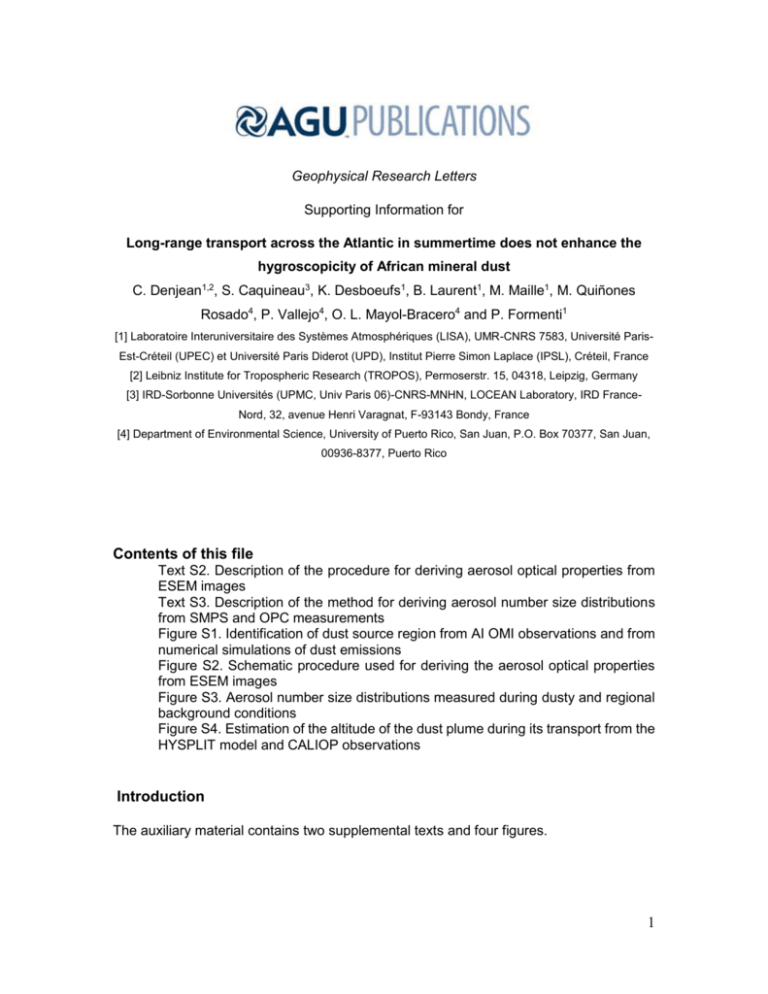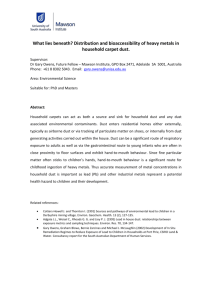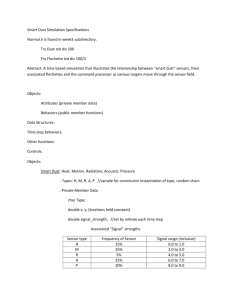grl53375-sup-0001-SuppInfo
advertisement

Geophysical Research Letters Supporting Information for Long-range transport across the Atlantic in summertime does not enhance the hygroscopicity of African mineral dust 1,2 C. Denjean , S. Caquineau3, K. Desboeufs1, B. Laurent1, M. Maille1, M. Quiñones Rosado4, P. Vallejo4, O. L. Mayol-Bracero4 and P. Formenti1 [1] Laboratoire Interuniversitaire des Systèmes Atmosphériques (LISA), UMR-CNRS 7583, Université ParisEst-Créteil (UPEC) et Université Paris Diderot (UPD), Institut Pierre Simon Laplace (IPSL), Créteil, France [2] Leibniz Institute for Tropospheric Research (TROPOS), Permoserstr. 15, 04318, Leipzig, Germany [3] IRD-Sorbonne Universités (UPMC, Univ Paris 06)-CNRS-MNHN, LOCEAN Laboratory, IRD FranceNord, 32, avenue Henri Varagnat, F-93143 Bondy, France [4] Department of Environmental Science, University of Puerto Rico, San Juan, P.O. Box 70377, San Juan, 00936-8377, Puerto Rico Contents of this file Text S2. Description of the procedure for deriving aerosol optical properties from ESEM images Text S3. Description of the method for deriving aerosol number size distributions from SMPS and OPC measurements Figure S1. Identification of dust source region from AI OMI observations and from numerical simulations of dust emissions Figure S2. Schematic procedure used for deriving the aerosol optical properties from ESEM images Figure S3. Aerosol number size distributions measured during dusty and regional background conditions Figure S4. Estimation of the altitude of the dust plume during its transport from the HYSPLIT model and CALIOP observations Introduction The auxiliary material contains two supplemental texts and four figures. 1 Text S2. Procedure for deriving the aerosol optical properties from ESEM images Aerosol optical properties (kext, ω0, and g) were calculated for λ = 550 nm from the GF and the refractive index of the particles at different RH using three different optical scenarios: homogeneous mixing, core-shell and compact aggregated spheres. The schematic procedure used for deriving aerosol optical properties from ESEM images is shown in Figure S2. The cross-sectional diameter Dc of the particles at different RH were determined from twodimensional ESEM images. In the absence of a technique to estimate the contact angle between the particles and the Cu-grid, we assumed that particles are spherical and the cross-sectional diameter Dc as a rough estimate for the volume equivalent diameter Dv. The hygroscopic growth factor (GF) was calculated as the ratio of Dv at a given RH to Dv at 5% RH, for each particle type. Since the refractive index is related to the aerosol chemical composition, it is expected to be influenced by atmospheric processing. Analysis of the elemental composition by EDX showed that most of mineral dust were chemically unprocessed. Firstly, the contribution of individual minerals to the dust sampled at Puerto Rico was similar as the contribution observed for dust in African source region (Formenti et al., 2014; Scheuvens et al., 2013) and over the Atlantic Ocean after short-range transport (Kandler et al., 2011). In particular, the contribution of iron oxides in mineral dust that are the main absorbing constituents of mineral dust (Muller et al., 2009) was less than 1% to the dust sampled at Puerto Rico. Secondly, the great majority of mineral dust was externally mixed with other atmospheric species. Therefore, we considered a refractive index similar as those observed in source region. In Africa, the real part and imaginary parts of the refractive index for mineral dust range between 1.51-1.57 and 0.0001-0.0046, respectively (Schladitz et al., 2009; Formenti et al., 2011; Ryder et al., 2013). The value of refractive index adopted in the paper (1.53-0.0020i) represents an average of the values reported in the literature. We assumed a density for mineral dust of 2.6 g cm-3 as reported by Hess et al. (1998). For the homogeneous mixing scenario, the calculations of refractive index were based on volume weighted refractive indices of mineral dust, NaCl and water: 𝑚𝑎𝑒𝑟𝑜𝑠𝑜𝑙 = 𝑚𝑑𝑢𝑠𝑡 . 𝑥𝑑𝑢𝑠𝑡 + 𝑚𝑁𝑎𝐶𝑙 . 𝑥𝑁𝑎𝐶𝑙 + 𝑚𝑤𝑎𝑡𝑒𝑟 . 𝑥𝑤𝑎𝑡𝑒𝑟 (1) where mdust, mNaCl and mwater are the real part of the refractive index of mineral dust, NaCl and water, respectively, and χdust, χNaCl and χwater the volume fraction of mineral dust, NaCl and water, respectively. 2 Similarly, the imaginary part of the refractive index k and the density ρ were calculated as follows: 𝑘𝑎𝑒𝑟𝑜𝑠𝑜𝑙 = 𝑘𝑑𝑢𝑠𝑡 . 𝑥𝑑𝑢𝑠𝑡 + 𝑘𝑁𝑎𝐶𝑙 . 𝑥𝑁𝑎𝐶𝑙 + 𝑘𝑤𝑎𝑡𝑒𝑟 . 𝑥𝑤𝑎𝑡𝑒𝑟 (2) 𝜌𝑎𝑒𝑟𝑜𝑠𝑜𝑙 = 𝜌𝑑𝑢𝑠𝑡 . 𝑥𝑑𝑢𝑠𝑡 + 𝜌𝑁𝑎𝐶𝑙 . 𝑥𝑁𝑎𝐶𝑙 + 𝜌𝑤𝑎𝑡𝑒𝑟 . 𝑥𝑤𝑎𝑡𝑒𝑟 (3) For the core-shell scenario, we assumed that particles were composed of a core that has the same refractive index and density as mineral dust and a NaCl mantle. We made the assumption that the mineral dust core size, density and refractive index did not change with RH. Therefore, changes of particle’ size, density and refractive index resulted from the change of the mantle thickness coating by NaCl particle. The refractive index and density of the mantle were calculated using the volume weighted refractive indices of NaCl and water: 𝑚𝑎𝑒𝑟𝑜𝑠𝑜𝑙 = 𝑚𝑁𝑎𝐶𝑙 . 𝑥𝑁𝑎𝐶𝑙 + 𝑚𝑤𝑎𝑡𝑒𝑟 . 𝑥𝑤𝑎𝑡𝑒𝑟 (4) For the compact aggregated spheres scenario, two aggregated particles with distinct sizes, refractive indexes and densities were simulated. The size, refractive index and density of mineral dust were assumed to remain constant with RH. The refractive index and density of NaCl particles were calculated using the volume weighted refractive indices of NaCl and water (i.e. equation (4)). The manufacturer-specified uncertainties for pressure and temperature sensors in the sample chamber of the ESEM-EDX were used to calculate the uncertainties in RH. The uncertainties in GF were estimated from the errors in the estimation of the volume equivalent diameter from ESEM images. The uncertainties on kext, g and w0 arise from the uncertainties on GF used for optical calculations. 3 Text S3. Method for deriving aerosol number size distributions from SMPS and OPC measurements The aerosol number size distribution was measured using a Scanning Mobility Particle Sizer (SMPS, TSI, model 3081) and an optical particle counter (OPC, GRIMM, model 1.109). The SMPS system provided the number size distribution of the electrical mobility diameter in the 11.8-593.5 nm range over time scans lasting 120 seconds. Data were corrected for the diffusion losses of particles in the SMPS tubing, the contribution of multicharged particles and the dilution of the aerosol flow before entering the CPC. The electrical mobility diameters Dm obtained from SMPS measurements were converted to the sphereequivalent particle geometric diameter Dg using the dynamic shape factor 𝒳: 𝐷𝑔 = 𝐷𝑚 𝒳 (5) The dynamic shape factor 𝒳 was set to 1.2 as obtained for randomly-oriented elongated particles (Hinds, 1999). This value has also been the choice of most of the studies dealing with particle size distribution of mineral dust (Reid et al., 2003; Weinzierl et al., 2009; 2011; Ryder et al., 2013). The GRIMM measured the number concentration of particles of optical diameter in the 0.25-32 µm range with a time resolution of 5 minutes. The conversion of optical diameter to sphere-equivalent diameter was performed using Mie scattering theory for homogeneous spheres (Bohren and Huffman, 1983) with a complex refractive index of 1.53 – 0.002i, which corresponds to the average of the values reported in the Africa source region. Further details on the choice of the complex refractive index is provided in section S2. Figure S3 shows the averaged size distributions measured by the SMPS and the GRIMM during the dust event on July 02, 2012 and under regional background conditions on June 29, 2012. The resulting number size distributions were parameterized by fitting four lognormal distributions as: 4 (𝑙𝑜𝑔𝐷𝑝 − 𝑙𝑜𝑔𝐷𝑝,𝑔,𝑖 )² 𝑑𝑁 𝑁𝑡𝑜𝑡,𝑖 =∑ 𝑒𝑥𝑝 [− ] 𝑑𝑙𝑜𝑔𝐷𝑝 2(𝑙𝑜𝑔𝜎𝑖 )² 𝑖=1 √2𝜋. 𝑙𝑜𝑔𝜎𝑖 (6) each mode i being characterized by characterized by the integrated number concentration Ntot,i, the geometric median diameter Dp,g,i and the geometric standard deviation σi. 4 (a) (b) Figure S1. Identification of the dust source regions from (a) the daily Aerosol Indexes (AI) derived from the Ozone Monitoring Instrument (OMI) level 3 products aboard the EOSAura platform and (b) from numerical simulations of dust emissions using the dust production model developed by Marticorena and Bergametti (1995), which run on a domain extending from 12°N to 38°N and 18°W to 40° E and included the North African dust sources. The dust event reaching Puerto-Rico in July 02 corresponds to E3 in Figure (a). Dust source activations occurred in Mauritania, Western Sahara and Central Algeria. No OMI AI data was available above the Atlantic Ocean in July 02, but E3a and E3b are clearly shown above Puerto-Rico in July 01 and July 03. 5 (a) (b) (c) Homogeneous mixing NaCl Dc 2 µm Aluminosilicate Core-shell model Dv Compact aggregated sphere Figure S2. NaCl aggregated to dust particles. (a) ESEM image, (b) simulated 3-D shape of the particle and (c) different optical models employed for calculating aerosol optical properties. Dc and Dv on the sketches represent the cross-sectional diameter and volume equivalent diameter, respectively. 6 10000 3 dN/dlogDp (#/cm ) 1000 100 10 1 0.1 0.01 0.001 0.01 GRIMM SMPS Col 56 vs Col 57 Parameterization Col 42 vs Col 47 Modes Col 42 vs Col 43 Dust event Regional background 0.1 1 10 Diameter (µm) Figure S3. Mean number size distributions obtained during the dust event (red) and the regional background (blue). Horizontal errors bars indicate the uncertainties on the sizing of the instruments. Vertical errors bars indicate one standard deviation of the number concentrations measured during the periods. 7 Figure S4. Five-day back-trajectory calculations performed with the HYSPLIT (Hybrid Single-Particle Lagrangian Integrated Trajectory) model and the Global Data Assimilation System (GDAS), and observations from the Cloud-Aerosol Lidar with Orthogonal Polarization (CALIOP) carried on the CALIPSO satellite. 8 Supporting information reference Bohren, C. F., and Huffman, D. R.: Absorption and scattering of light by small particles, Wiley, New York, 1983. Formenti, P., Rajot, J. L., Desboeufs, K., Saïd, F., Grand, N., Chevaillier, S., and Schmechtig, C.: Airborne observations of mineral dust over western Africa in the summer Monsoon season: spatial and vertical variability of physico-chemical and optical properties, Atmos. Chem. Phys., 11, 6387-6410, 10.5194/acp-11-6387-2011, 2011. Formenti, P., Caquineau, S., Desboeufs, K., Klaver, A., Chevaillier, S., Journet, E., and Rajot, J. L.: Mapping the physico-chemical properties of mineral dust in western Africa: mineralogical composition, Atmos. Chem. Phys., 14, 10663-10686, 10.5194/acp-1410663-2014, 2014. Hess, M., Koepke, P., and Schult, I.: Optical Properties of Aerosols and Clouds: The Software 8 Package OPAC, Bulletin of the American Meteorological Society, 79, 831-844, 10.1175/1520-9 0477(1998)079<0831:OPOAAC>2.0.CO;2, 1998. Hinds, W. C.: Aerosol Technology: Properties, Behavior, and Measurement of Airborne Particles, 1999. Kandler, K., Lieke, K., Benker, N., Emmel, C., KÜPper, M., MÜLler-Ebert, D., Ebert, M., Scheuvens, D., Schladitz, A., SchÜTz, L., and Weinbruch, S.: Electron microscopy of particles collected at Praia, Cape Verde, during the Saharan Mineral Dust Experiment: particle chemistry, shape, mixing state and complex refractive index, Tellus B, 63, 475496, 10.1111/j.1600-0889.2011.00550.x, 2011. Marticorena, B. and Bergametti, G.: Modelling the atmospheric dust cycle: 1. Design of a soil derived dust production scheme, J. Geophys. Res., 100, 16415–16430, 1995. Müller, T., Schladitz, A., Massling, A., Kaaden, N., Kandler, K., and Wiedensohler, A.: Spectral absorption coefficients and imaginary parts of refractive indices of Saharan dust during SAMUM-1, Tellus B, 61, 79-95, 10.1111/j.1600-0889.2008.00399.x, 2009. Reid, E. A., Reid, J. S., Meier, M. M., Dunlap, M. R., Cliff, S. S., Broumas, A., Perry, K., and Maring, H.: Characterization of African dust transported to Puerto Rico by individual particle and size segregated bulk analysis, Journal of Geophysical Research: Atmospheres, 108, 8591, 10.1029/2002JD002935, 2003. Ryder, C. L., Highwood, E. J., Rosenberg, P. D., Trembath, J., Brooke, J. K., Bart, M., Dean, A., Crosier, J., Dorsey, J., Brindley, H., Banks, J., Marsham, J. H., McQuaid, J. B., Sodemann, H., and Washington, R.: Optical properties of Saharan dust aerosol and contribution from the coarse mode as measured during the Fennec 2011 aircraft campaign, Atmospheric Chemistry and Physics, 13, 303-325, 10.5194/acp-13-303-2013, 2013. Scheuvens, D., Schütz, L., Kandler, K., Ebert, M., and Weinbruch, S.: Bulk composition of northern African dust and its source sediments — A compilation, Earth-Science Reviews, 116, 170-194, http://dx.doi.org/10.1016/j.earscirev.2012.08.005, 2013. Schladitz, A., Muller, T., Kaaden, N., Massling, A., Kandler, K., Ebert, M., Weinbruch, S., Deutscher, C., and Wiedensohler, A.: In situ measurements of optical properties at Tinfou (Morocco) during the Saharan Mineral Dust Experiment SAMUM 2006, Tellus Series BChemical and Physical Meteorology, 61, 64-78, 10.1111/j.1600-0889.2008.00397.x, 2009. Weinzierl, B., Petzold, A., Esselborn, M., Wirth, M., Rasp, K., Kandler, K., SchÜTz, L., Koepke, P., and Fiebig, M.: Airborne measurements of dust layer properties, particle size 9 distribution and mixing state of Saharan dust during SAMUM 2006, Tellus B, 61, 96-117, 10.1111/j.1600-0889.2008.00392.x, 2009. Weinzierl, B., Sauer, D., Esselborn, M., Petzold, A., Veira, A., Rose, M., Mund, S., Wirth, M., Ansmann, A., Tesche, M., Gross, S., and Freudenthaler, V.: Microphysical and optical properties of dust and tropical biomass burning aerosol layers in the Cape Verde regionan overview of the airborne in situ and lidar measurements during SAMUM-2, Tellus Series B-Chemical and Physical Meteorology, 63, 589-618, 10.1111/j.16000889.2011.00566.x, 2011. 10





